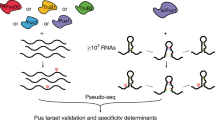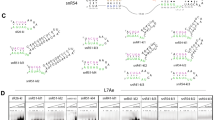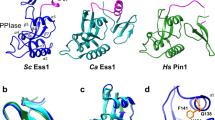Abstract
The 5′→3′ exoribonucleases (XRNs) have important functions in transcription, RNA metabolism and RNA interference. The structure of Rat1 (also known as Xrn2) showed that the two highly conserved regions of XRNs form a single, large domain that defines the active site of the enzyme. Xrn1 has a 510-residue segment after the conserved regions that is required for activity but is absent from Rat1/Xrn2. Here we report the crystal structures of Kluyveromyces lactis Xrn1 (residues 1–1,245, E178Q mutant), alone and in complex with a Mn2+ ion in the active site. The 510-residue segment contains four domains (D1–D4), located far from the active site. Our mutagenesis and biochemical studies show that their functional importance results from their ability to stabilize the conformation of the N-terminal segment of Xrn1. These domains might also constitute a platform that interacts with protein partners of Xrn1.
This is a preview of subscription content, access via your institution
Access options
Subscribe to this journal
Receive 12 print issues and online access
$189.00 per year
only $15.75 per issue
Buy this article
- Purchase on Springer Link
- Instant access to full article PDF
Prices may be subject to local taxes which are calculated during checkout







Similar content being viewed by others
References
Parker, R. & Song, H. The enzymes and control of eukaryotic mRNA turnover. Nat. Struct. Mol. Biol. 11, 121–127 (2004).
Newbury, S.F. Control of mRNA stability in eukaryotes. Biochem. Soc. Trans. 34, 30–34 (2006).
Bousquet-Antonelli, C., Presutti, C. & Tollervey, D. Identification of a regulated pathway for nuclear pre-mRNA turnover. Cell 102, 765–775 (2000).
Gatfield, D. & Izaurralde, E. Nonsense-mediated messenger RNA decay is initiated by endonucleolytic cleavage in Drosophila. Nature 429, 575–578 (2004).
Coller, J. & Parker, R. Eukaryotic mRNA decapping. Annu. Rev. Biochem. 73, 861–890 (2004).
Zabolotskaya, M.V., Grima, D.P., Lin, M.-D., Chou, T.-B. & Newbury, S.F. The 5′-3′ exoribonuclease Pacman is required for normal male fertility and is dynamically loalized in cytoplasmic particles in Drosophila testis cells. Biochem. J. 416, 327–335 (2008).
Amberg, D.C., Goldstein, A.L. & Cole, C.N. Isolation and characterization of RAT1: an essential gene of Saccharymyces cerevisiae required for the efficient nucleocytoplasmic trafficking of mRNA. Genes Dev. 6, 1173–1189 (1992).
Kenna, M., Stevens, A., McCammon, M. & Douglas, M.G. An essential yeast gene with homology to the exonuclease-encoding XRN1/KEM1 gene also encodes a protein with exoribonuclease activity. Mol. Cell. Biol. 13, 341–350 (1993).
di Segni, G., McConaughy, B.L., Shapiro, R.A., Aldrich, T.L. & Hall, B.D. TAP1, a yeast gene that activates the expression of a tRNA gene with a defective internal promoter. Mol. Cell. Biol. 13, 3424–3433 (1993).
Kim, M. et al. The yeast Rat1 exonuclease promotes transcription termination by RNA polymerase II. Nature 432, 517–522 (2004).
West, S., Gromak, N. & Proudfoot, N.J. Human 5′→3′ exonuclease Xrn2 promotes transcription termination at co-transcriptional cleavage sites. Nature 432, 522–525 (2004).
Luo, W., Johnson, A.W. & Bentley, D.L. The role of Rat1 in coupling mRNA 3′-end processing to transcription termination: implications for a unified allosteric-torpedo model. Genes Dev. 20, 954–965 (2006).
Kaneko, S., Rozenblatt-Rosen, O., Meyerson, M. & Manley, J.L. The multifunctional protein p54nrb/PSF recruits the exonuclease XRN2 to facilitate pre-mRNA 3′ processing and transcription termination. Genes Dev. 21, 1779–1789 (2007).
El Hage, A., Koper, M., Kufel, J. & Tollervey, D. Efficient termination of transcription by RNA polymerase I requires the 5′ exonuclease Rat1 in yeast. Genes Dev. 22, 1069–1081 (2008).
Kawauchi, J., Mischo, H., Braglia, P., Rondon, A. & Proudfoot, N.J. Budding yeast RNA polymerases I and II employ parallel mechnisms of transcriptional termination. Genes Dev. 22, 1082–1092 (2008).
Luke, B. et al. The Rat1p 5′ to 3′ exonuclease degrades telomeric repeat-containing RNA and promotes telomere elongation in Saccharomyces cerevisiae. Mol. Cell 32, 465–477 (2008).
Chernyakov, I., Whipple, J.M., Kotelawala, L., Grayhack, E.J. & Phizicky, E.M. Degradation of several hypomodified mature tRNA species in Saccharocmyces cerevisiae is mediated by Met22 and the 5′-3′ exonucleases Rat1 and Xrn1. Genes Dev. 22, 1369–1380 (2008).
Shobuike, T., Tatebayashi, K., Tani, T., Sugano, S. & Ikeda, H. The dhp1+ gene, encoding a putative nuclear 5′→3′ exoribonuclease, is required for proper chromosome segregation in fission yeast. Nucleic Acids Res. 29, 1326–1333 (2001).
Gy, I. et al. Arabidopsis FIERY1, XRN2, and XRN3 are endogenous RNA silencing suppressors. Plant Cell 19, 3451–3461 (2007).
Olmedo, G. et al. Ethylene-insensitive5 encodes a 5′→3′ exoribonuclease required for regulation of the EIN3-targeting F-box proteins EBF1/2. Proc. Natl. Acad. Sci. USA 103, 13286–13293 (2006).
Potuschak, T. et al. The exoribonuclease XRN4 is a component of the ethylene response pathway in Arabidopsis. Plant Cell 18, 3047–3057 (2006).
Gazzani, S., Lawrenson, T., Woodward, C., Headon, D. & Sablowski, R. A link between mRNA turnover and RNA interference in Arabidopsis. Science 306, 1046–1048 (2004).
Page, A.M., Davis, K., Molineux, C., Kolodner, R.D. & Johnson, A.W. Mutational analysis of exoribonuclease I from Saccharomyces cerevisiae. Nucleic Acids Res. 26, 3707–3716 (1998).
Solinger, J.A., Pascolini, D. & Heyer, W.-D. Active-site mutations in the Xrn1p exoribonuclease of Saccharomyces cerevisiae reveal a specific role in meiosis. Mol. Cell. Biol. 19, 5930–5942 (1999).
Yang, W., Lee, J.Y. & Nowotny, M. Making and breaking nucleic acids: Two-Mg2+-ion catalysis and substrate specificity. Mol. Cell 22, 5–13 (2006).
Xiang, S. et al. Structure and function of the 5′→3′ exoribonuclease Rat1 and its activating partner Rai1. Nature 458, 784–788 (2009).
Xue, Y. et al. Saccharomyces cerevisiae RAI1 (YGL246c) is homologous to human DOM3Z and encodes a protein that binds the nuclear exoribonuclease Rat1p. Mol. Cell. Biol. 20, 4006–4015 (2000).
Stevens, A. & Poole, T.L. 5′-exonuclease-2 of Saccharomyces cerevisiae. Purification and features of ribonuclease activity with comparison to 5′-exonuclease-1. J. Biol. Chem. 270, 16063–16069 (1995).
Hendrickson, W.A. Determination of macromolecular structures from anomalous diffraction of synchrotron radiation. Science 254, 51–58 (1991).
Maurer-Stroh, S. et al. The tudor domain 'royal family': tudor, plant Agenet, chromo, PWWP and MBT domains. Trends Biochem. Sci. 28, 69–74 (2003).
Holm, L., Kaariainen, S., Rosenstrom, P. & Schenkel, A. Searching protein structure databases with DaliLite v.3. Bioinformatics 24, 2780–2781 (2008).
Sun, B. et al. Molecular basis of the interaction of Saccharomyces cerevisiae Eaf3 chromo domain with methylated H3K36. J. Biol. Chem. 283, 36504–36512 (2008).
Xu, C., Cui, G., Botuyan, M.V. & Mer, G. Structural basis for the recognition of methylated histone H3K36 by the Eaf3 subunit of histone deacetylase complex Rpd3S. Structure 16, 1740–1750 (2008).
Huang, Y., Fang, J., Bedford, M.T., Zhang, Y. & Xu, R.-M. Recognition of histone H3 lysine-4 methylation by the double tudor domain of JMJD2A. Science 312, 748–751 (2006).
Steiner, T., Kaiser, J.T., Marinkovic, S., Huber, R. & Wahl, M.C. Crystal structures of transcription factor NusG in light of its nucleic acid- and protein-binding activities. EMBO J. 21, 4641–4653 (2002).
Burmann, B.M. et al. A NusE:NusG complex links transcription and translation. Science 328, 501–504 (2010).
Sokolowska, M., Czapinska, H. & Bochtler, M. Crystal structure of the bba-Me type II restriction endonuclease Hpy99I with target DNA. Nucleic Acids Res. 37, 3799–3810 (2009).
Kaustov, L. et al. The conserved CPH domains of Cul7 and PARC are protein-protein interaction modules that bind the tetramerization domain of p53. J. Biol. Chem. 282, 11300–11307 (2007).
Huyen, Y. et al. Methylated lysine 79 of histone H3 targets 53BP1 to DNA double-strand breaks. Nature 432, 406–411 (2004).
Charier, G. et al. The tudor tandem of 53BP1: A new structural motif involved in DNA and RG-rich peptide binding. Structure 12, 1551–1562 (2004).
Botuyan, M.V. et al. Structural basis for the methylation state-specific recognition of histone H4–K20 by 53BP1 and Crb2 in DNA repair. Cell 127, 1361–1373 (2006).
Vedadi, M. et al. Chemical screening methods to identify ligands that promote protein stability, protein crystallization, and structure determination. Proc. Natl. Acad. Sci. USA 103, 15835–15840 (2006).
Syson, K. et al. Three metal ions participate in the reaction catalyzed by T5 Flap endonuclease. J. Biol. Chem. 283, 28741–28746 (2008).
Mueser, T.C., Nossal, N.G. & Hyde, C.C. Structure of bacteriophage T4 RNase H, a 5′ to 3′ RNA-DNA and DNA-DNA exonuclease with sequence similarity to the RAD2 family of eukaryotic proteins. Cell 85, 1101–1112 (1996).
Hwang, K.Y., Baek, K., Kim, H.-Y. & Cho, Y. The crystal structure of flap endonuclease-1 from Methanococcus jannaschii. Nat. Struct. Biol. 5, 707–713 (1998).
Feng, M. et al. Roles of divalent metal ions in flap endonuclease-substrate interactions. Nat. Struct. Mol. Biol. 11, 450–456 (2004).
Sakurai, S. et al. Structural basis for recruitment of human flap endonuclease 1 to PCNA. EMBO J. 24, 683–693 (2005).
Doré, A.S. et al. Structure of an archael PCNA1-PCNA2–FEN1 complex: elucidating PCNA subunit and client enzyme specificity. Nucleic Acids Res. 34, 4515–4526 (2006).
Jiao, X. et al. Identification of a quality-control mechanism for mRNA 5′-end capping. Nature 467, 608–611 (2010).
Nicholls, A., Sharp, K.A. & Honig, B. Protein folding and association: insights from the interfacial and thermodynamic properties of hydrocarbons. Proteins 11, 281–296 (1991).
Armon, A., Graur, D. & Ben-Tal, N. ConSurf: an algorithmic tool for the identification of functional regions in proteins by surface mapping of phylogenetic information. J. Mol. Biol. 307, 447–463 (2001).
Doublié, S. et al. Crystallization and preliminary X-ray analysis of the 9 kDa protein of the mouse signal recognition particle and the selenomethionyl-SRP9. FEBS Lett. 384, 219–221 (1996).
Otwinowski, Z. & Minor, W. Processing of X-ray diffraction data collected in oscillation mode. Methods Enzymol. 276, 307–326 (1997).
McCoy, A.J. et al. Phaser crystallographic software. J. Appl. Crystallogr. 40, 658–674 (2007).
CCP4. The CCP4 suite: programs for protein crystallography. Acta Crystallogr. D Biol. Crystallogr. 50, 760–763 (1994).
Jones, T.A., Zou, J.Y., Cowan, S.W. & Kjeldgaard, M. Improved methods for building protein models in electron density maps and the location of errors in these models. Acta Crystallogr. A 47, 110–119 (1991).
Emsley, P. & Cowtan, K.D. Coot: model-building tools for molecular graphics. Acta Crystallogr. D Biol. Crystallogr. 60, 2126–2132 (2004).
Brünger, A.T. et al. Crystallography & NMR System: A new software suite for macromolecular structure determination. Acta Crystallogr. D Biol. Crystallogr. 54, 905–921 (1998).
Murshudov, G.N., Vagin, A.A. & Dodson, E.J. Refinement of macromolecular structures by the maximum-likelihood method. Acta Crystallogr. D Biol. Crystallogr. 53, 240–255 (1997).
Takagaki, Y., Ryner, L.C. & Manley, J.L. Separation and characterization of a Poly(A) polymerase and a cleavage/specificity factor required for pre-mRNA polyadenylation. Cell 52, 731–742 (1988).
Acknowledgements
We thank N. Whalen and S. Myers for setting up the X29A beamline at the National Synchrontron Light Source (NSLS). This research was supported in part by grants from the US National Institutes of Health to L.T. (GM090059 and GM077175) and J.L.M. (GM028983).
Author information
Authors and Affiliations
Contributions
J.H.C. and S.X. carried out protein expression, purification and crystallization experiments. J.H.C., S.X. and L.T. carried out crystallographic data collection, structure determination and refinement. J.H.C. carried out mutagenesis, nuclease assays, EMSA and thermal shift experiments. K.X. helped with the preparation of the nuclease substrate. J.L.M. designed experiments and analyzed data. All authors commented on the manuscript. L.T. designed experiments, analyzed data and wrote the paper.
Corresponding author
Ethics declarations
Competing interests
The authors declare no competing financial interests.
Supplementary information
Supplementary Text and Figures
Supplementary Figures 1–9 (PDF 3160 kb)
Rights and permissions
About this article
Cite this article
Chang, J., Xiang, S., Xiang, K. et al. Structural and biochemical studies of the 5′→3′ exoribonuclease Xrn1. Nat Struct Mol Biol 18, 270–276 (2011). https://doi.org/10.1038/nsmb.1984
Received:
Accepted:
Published:
Issue Date:
DOI: https://doi.org/10.1038/nsmb.1984
This article is cited by
-
Xrn1 is a deNADding enzyme modulating mitochondrial NAD-capped RNA
Nature Communications (2022)
-
Observation of conformational changes that underlie the catalytic cycle of Xrn2
Nature Chemical Biology (2022)
-
RNA-controlled nucleocytoplasmic shuttling of mRNA decay factors regulates mRNA synthesis and a novel mRNA decay pathway
Nature Communications (2022)
-
A structured RNA motif locks Argonaute2:miR-122 onto the 5’ end of the HCV genome
Nature Communications (2021)
-
Pseudoknot length modulates the folding, conformational dynamics, and robustness of Xrn1 resistance of flaviviral xrRNAs
Nature Communications (2021)



